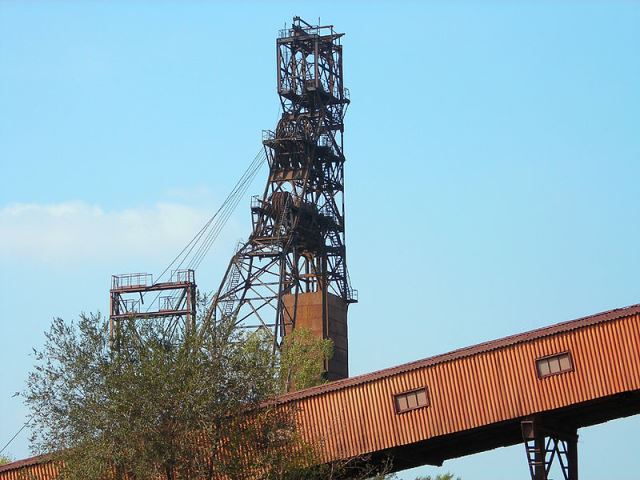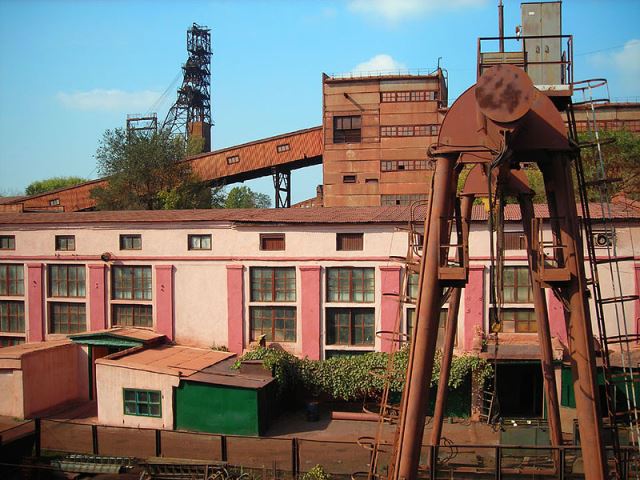
Gvardiyska iron ore mine is a part of PJSC "Kryvyi Rih Iron-Ore complex". Designed capacity of the mine is 2 million tons of rich ore. Horizons of 1190 and 1270 meters were commissioned. Ore iron content is 59,6%. Iron ore mining operations within the limits of Gvardiyska mining lease were started in 1886 by the Brianskyi (Olexandrivskyi mine), Verkhnodniprovskyi and Nikopol-Mariupol Metallurgical Society.
Underground mining started in 1907, when the following mines were put into operation: Khodzynska (based on Karernyi deposit), № 1(based on deposits 1, 2, 3) and № 5 (on deposits of Gnizdo І-ІІ). In 1913 at the former Olexandrivskyi Mine there were two open pits and three mines which were operating all the time, later they were destroyed and flooded during the First World War and Civil War.
In March, 1923 the Chervonoi Gvardii (Red Guard) Minery was established. In the middle of the year 1925 Khodzynska Mine was renewed (later it was renamed – Rosa Luxemburg Mine). Until the year 1930 the renewed mines and open pits produced up to 600 thousand tons of ore per year. In 1930 the shafts of Komsomol Mine and Red Miner Mine were operated (they were established at the place of old mines № 1 and № 5). Due to some prospecting works conducted by means of 30 pit-holes, new deposits of South, East, North-East, North were discovered. In 1939 the Nova (New) Mine was commissioned. The Nova (New) Mine was equipped with the most advanced at that time mining techniques.
In May 1939 the Minery named after Chervona Gvardiya (Red Guard) joined the Rose Luxembourg Mine management which was a part of the newly formed Leningrad Trust. For the years of the Minery operation the extraction systems, the level of mechanization, automation of production processes and work organization were of crucial importance for the development of mining activities. During the occupation period 1941-1945 the Nova Mine was non-operating it was thoroughly blown up and destroyed, underground horizons were waterlogged. Komsomolka Mine was completely recommenced in 1948, the Red Miner Mine - in 1949. In 1951 the Nova Mine reached and surpassed pre-war levels of iron ore extraction.
After lowering the mining operations to a depth of 500 meters the lifting capabilities of the shafts of the Nova Mine, Komsomolka and "Komsomolskaya 1" (commissioned in Nov. 4, 1957) were almost exhausted. In order to provide a perspective lifting from the great depth a general reconstruction was carried out on the minery and was completed in 1965. From the east part of the Nova Mine shaft the twin shafts of the Gvardiyska Mine with a diameter of 7.5 m were passed. Concrete tower headframes of 96 m were constructed above the mine shafts.

Each headframe is equipped with skip multiple-rope hoist machine MK 5*4 and cage winding machine. Skip capacity with bottom unloading is 25 tons. Cages are two-storeyed and designed for giving 10-ton cars. After the commissioning of the Gvardiyska Mine the problem of centralization of deposit development was solved.
The movement of extracted ore both under the ground and on the surface is now concentrated in a single flow. Due to the commissioning of the Gvardiyska Mine in 1966, Komsomolska-1 and Komsomolka Mines were liquidated as independent mining points. The shaft of the Nova Mine was used for opening the deposits in deep horizons. Currently the shaft of the Pivnichna-Ventylyatsiyna (North and Ventilation) Mine is operating.
At present, purification excavations are performed on the horizons of 1190 meters. The horizons of -1270 and -1350 meters are also under development, the shafts of the Gvardiyska Mine were deepened to -1430 m, Nova Mine to -1590 m, Pivnichna-Ventylyatsiyna (North and Ventilation) Mine -1350 m, haulage cross-cut and drifts were passed on horizons of 1270 and 1350 m.
The proven rich iron ore reserves have been explored to a depth of 1990 meters and are amounted up to 126.1 million tons (with an iron content of 60.52%).Now the Finnish high production mining and tunneling complex and a combine for menless mining of rising working-out are working here. According to the mining and geological conditions the purification excavations is being done by means of systems with leaning rockslide as well as surface-chamber system.
Fractional share at the total production of ore extraction from the development system is as follows:
• surface-chamber - 58.9%;
• systems with leaning rockslide- 41.1%.
Provision of the mine with explored balance reserves is 40 years upon condition of designed capacity of 2 million tons of ore extraction.

